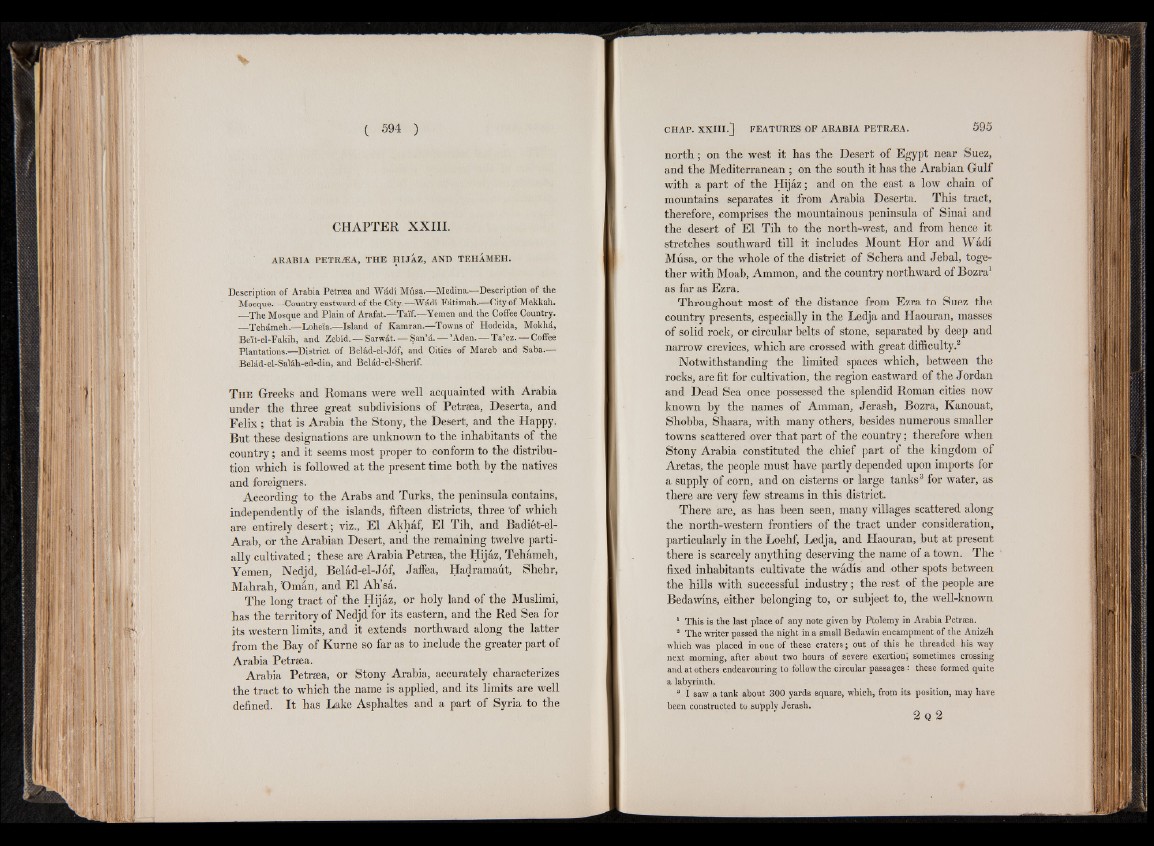
CHAPTER XXIII.
ARABIA I’ETRiEA, THE HIjiz, AND TEHAMEH.
Description of Arabia Petreea and Wddl Miisa.—Medina.—Description of the
Mosque.—Country eastward of the City.—Wadi Fdtimah.—City of Mekkah.
—The Mosque and Plain of Arafat.—Taif.—Yemen and the Coffee Country.
•—Tehdmeh.—Lohe'ia.-—-Island of Kamran.—Towns of Hodeida, Mokhd,
Beit-el-Fakih, and Zehid. — Sarwdt.— San’d.—-’Aden. — Ta’ez. — Coffee
Plantations.—District of Beldd-el-J6f, and Cities of Mareb and Saha.—
Belad-el-Saldh-ed-din, and Beldd-el-Sherif.
T h e Greeks and Romans were well acquainted with Arabia
under the three great subdivisions of Petreea, Deserta, and
Felix ; that is Arabia the Stony, the Desert, and the Happy.
But these designations are unknown to the inhabitants of the
country; and it seems most proper to conform to the distribution
which is followed at the present time both by the natives
and foreigners.
According to the Arabs and Turks, the peninsula contains,
independently of the islands, fifteen districts, three 'of which
are entirely desert; viz., El Akhaf, El Tih, and Badiet-el-
Arab, or the Arabian Desert, and the remaining twelve partially
cultivated; these are Arabia Petrsea, the Hijaz, Tehameh,
Yemen, Nedjd, Belad-el-Jof, Jaffea, Hadramaut, Shehr,
Mahrah, ’Oman, and El Ah’sa.
The long tract of the Hijaz, or holy land of the Muslimi,
has the territory of Nedjd for its eastern, and the Red Sea for
its western limits, and it extends northward along the latter
from the Bay of Kurne so far as to include the greater part of
Arabia Petreea.
Arabia Petreea, or Stony Arabia, accurately characterizes
the tract to which the name is applied, and its limits are well
defined. It has Lake Asphaltes and a part of Syria to the
north; on the west it has the Desert of Egypt near Suez,
and the Mediterranean ; on the south it has the Arabian Gulf
with a part of the Hijaz; and on the east a low chain of
mountains separates it from Arabia Deserta. This tract,
therefore, comprises the mountainous peninsula of Sinai and
the desert of El Tih to the north-west, and from hence it
stretches southward till it includes Mount Hor and Wadi
Musa, or the whole of the district of Schera and Jebal, together
with Moab, Ammon, and the country northward of Bozra1
as far as Ezra.
Throughout most of the distance from Ezra to Suez the
country presents, especially in the Ledja and Haouran, masses
of solid rock, or circular belts of stone, separated by deep and
narrow crevices, which are crossed with great difficulty.2
Notwithstanding the limited spaces which, between the
rocks, are fit for cultivation, the region eastward of the Jordan
and Dead Sea once possessed the splendid Roman cities now
known by the names of Amman, Jerash, Bozra, Kanouat,
Shobba, Shaara, with many others, besides numerous smaller
towns scattered over that part of the country; therefore when
Stony Arabia constituted the chief part of the kingdom of
Aretas, the people must have partly depended upon imports for
a supply of corn, and on cisterns or large tanks3 for water, as
there are very few streams in this district.
There are, as has been seen, many villages scattered along
the north-western frontiers of the tract under consideration,
particularly in the Loehf, Ledja, and Haouran, but at present
there is scarcely anything deserving the name of a town. The
fixed inhabitants cultivate the wadis and other spots between
the hills with successful industry; the rest of the people are
Bedawlns, either belonging to, or subject to, the well-known
1 This is the last place of any note given by Ptolemy in Arabia Petrsea.
8 The writer passed the night in a small Bedawin encampment of the Anizeh
which was placed in one of these craters; out of this he threaded his way
next morning, after about two hours of severe exertion; sometimes crossing
and at others endeavouring to follow the circular passages : these formed quite
a labyrinth.
8 I saw a tank about 300 yards square, which, from its position, may have
been constructed to supply Jerash.